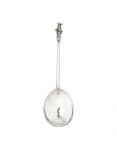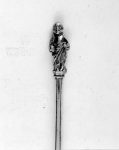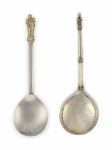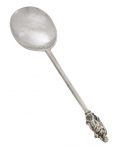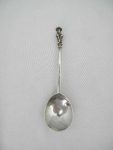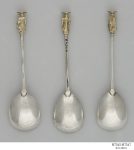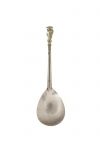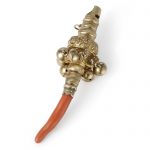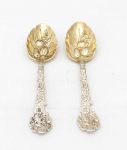Apostle Spoons were a popular and fashionable Christening Gift in Tudor and Stuart times. A full set of twelve was a very valuable gift. Some sets had thirteen and these included a spoon called “The Master” as it depicted the figure of Christ. It is virtually impossible to find a complete set with the Master nowadays. However, many sets of six were made in Victorian times. Single Apostle spoons can also be found. London Apostle spoons are marked with a leopard’s head in the bowl, near the base of the stem, and those made in the province carry the town or city marks in the same position. All other identifying marks are found on the reverse of the stem.
The other twelve apostles consist of St. Andrew, St. Bartholomew, St. James The Greater, St. James The Less, St. John, St. Jude, St. Matthias, St. Matthew, St. Paul, St. Philip, St. Simon Zelotes and St. Thomas and are identified by the emblem he is carrying. St Paul and St. James are the most frequently encountered. St. Paul is the patron saint of London.
A mid-17th century silver apostle spoon unascribed, marked once in the bowl and twice on the stem with a five-petal flower, probably West Country, circa 1639 The apostle finial with a Holy Dove nimbus, the back of the bowl dot-pricked ‘S*I S*I 1639’, length 18.4cm, weight 60gms.
Sold for £ 1,125 inc. premium at Bonhams in 2017
Apostle spoon; silver; gilt terminal of St Peter wearing a breast-plate; sacred monogram engraved in the bowl; London hallmarks and maker’s mark. Date 1536-1537
Reference: © The Trustees of the British Museum
A CONTINENTAL PARCEL-GILT SILVER APOSTLE SPOON MAKER’S MARK AM CONJOINED, 17TH CENTURY The back of the bowl, engraved with strapwork and with a putto mask terminal, the finial cast as St. Peter on an acanthus capped plinth, marked on back of bowl with maker’s mark only; Together with a Dutch silver spoon, with indistinct maker’s mark, dated 1719, the finial cast as a grotesque figure holding a shield, the back of the bowl engraved with later inscription dated 1719, marked on back of bowl The first, 8 in. (20.2 cm.) long The second, 6 3/4 in. (17.2 cm.) long 2 oz. 19 dwt. (125 gr.)
Sold for GBP 1,062 at Christies in 2016
James I Sterling Silver Apostle Spoon Maker’s mark rubbed, London, 1617 With fig-form bowl, the parcel gilt terminal depicting St. Andrew. Height 7 inches (17.8 cm.), approximately 1 ounce, 10 dwt.
Sold for $1,000 (includes buyer’s premium) at Doyle New York in 2017
Elizabeth I sterling silver apostle spoon, St James the Lesser, London 1570 having “AD” mono carved about London Lion head mark. Extraordinarily fine condition. 65 gr. Purchased London Sotheby P.B 2-Apr-81 lot 160 Catalog and receipt available
Sold for $2,750 at Gary Germer & Associates in 2018
Dutch Apostle Spoon circa probably 1629
Apostle spoons are thought to have originated in late-fifteenth century England but also became popular in the Netherlands, where household goods were frequently embellished with biblical imagery reminding the owner of Christian virtues. The sword identifies the apostle as Saint Paul. The decoration of the lower part of the stem, depicting Judith holding the head of Holofernes, is typical for the harbor city Enkhuizen, affluent thanks to its overseas trade with the East Indies
Reference: The Metropolitan Museum of Art
Spoon, St. Matthias the Apostle, silver / gilt, maker unknown, place unknown, 1645 Spoon, St. Matthias the Apostle, silver / gilt, maker unknown, place unknown, 1645 St. Matthias silver Apostle Spoon. Length 7 3/8”. Gilt figure holding an axe; plain nimbus with datemark 1645. Crowned leopard stamped on bowl.
Reference: Museum of Applied Art and Sciences
Apostle spoon English (London) 1545–56 Marked by William Simpson (apprenticed 1499, died about 1546)
The spoon has a fig-shaped bowl and a flattened, tapering hexagonal stem. The finial depicts Saint Thomas holding a spear in his right hand. The nimbus is rayed. The bowl and stem of the spoon are forged from a single piece. The apostle figure and nimbus are cast separately and applied. The finial is gilt. The bowl has been reworked.
Reference: Museum of Fine Arts Boston
Robert Wade, Taunton APOSTLE SPOON, ST. BARTHOLOMEW maker’s mark RW stamped thrice to the stem and once to the bowl, circa 1635 silver-gilt, rear of bowl prick-engraved with flowers above initials W.P over A.G over 1657 length: 18.4cm., 7 1/4 in.; weight: 56gr., 1oz. 16dwt. active mid-17th century
Sold for 1,875 GBP at Sotheby’s in 2018
Apostle spoon depicting St. John with deep fig-shaped bowl inscribed on the back with the initials IG, and a thick, tapering stem ending with a moulded capital, on which the figure stands. The figure holds a chalice with the left hand, out of which rises a creature, and gives the benediction with the right. The nimbus is engraved with rays. The bowl and stem were hammered, the ‘knop’ or finial, cast. The finial was then soldered to the stem, and attached using a ‘V’ shaped joint, characteristic of London spoonmakers of this period.
St John the Evangelist, the figure on the finial of this spoon, was one of four who described the life of Jesus in the gospels (with Matthew, Mark and Luke). By the 13th century, it was common to depict St John holding a chalice with a serpent or dragon rising from it. Many believe this refers to an incident where John was handed a cup of poisoned wine, which he blessed, and the poison rose out of the cup in the shape of a serpent. On this spoon, St John’s hand is raised in a blessing and he holds a cup out of which a creature emerges.
Reference: © Victoria and Albert Museum
